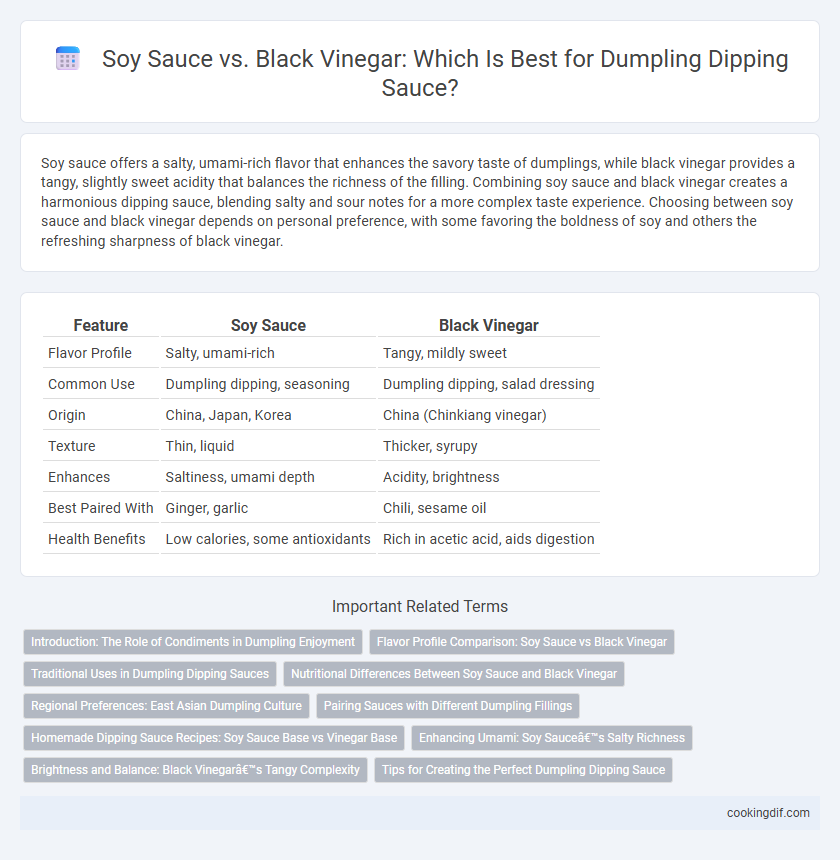Soy sauce offers a salty, umami-rich flavor that enhances the savory taste of dumplings, while black vinegar provides a tangy, slightly sweet acidity that balances the richness of the filling. Combining soy sauce and black vinegar creates a harmonious dipping sauce, blending salty and sour notes for a more complex taste experience. Choosing between soy sauce and black vinegar depends on personal preference, with some favoring the boldness of soy and others the refreshing sharpness of black vinegar.
Table of Comparison
| Feature | Soy Sauce | Black Vinegar |
|---|---|---|
| Flavor Profile | Salty, umami-rich | Tangy, mildly sweet |
| Common Use | Dumpling dipping, seasoning | Dumpling dipping, salad dressing |
| Origin | China, Japan, Korea | China (Chinkiang vinegar) |
| Texture | Thin, liquid | Thicker, syrupy |
| Enhances | Saltiness, umami depth | Acidity, brightness |
| Best Paired With | Ginger, garlic | Chili, sesame oil |
| Health Benefits | Low calories, some antioxidants | Rich in acetic acid, aids digestion |
Introduction: The Role of Condiments in Dumpling Enjoyment
Soy sauce and black vinegar play crucial roles in enhancing dumpling flavors, each bringing unique taste profiles that complement the dish. Soy sauce offers a salty, umami depth, while black vinegar adds a tangy, slightly sweet acidity that balances the richness of dumplings. Choosing the right condiment elevates the overall dining experience by highlighting textural contrasts and enriching the savory taste.
Flavor Profile Comparison: Soy Sauce vs Black Vinegar
Soy sauce offers a salty, umami-rich flavor that enhances the savory taste of dumplings, providing a deep, slightly sweet soy essence. Black vinegar delivers a complex, tangy acidity with subtle smoky and malty notes that balance the richness of dumplings and cut through their fattiness. Combining soy sauce and black vinegar creates a harmonious dipping sauce with bold umami and bright, sharp acidity, elevating the overall dumpling experience.
Traditional Uses in Dumpling Dipping Sauces
Soy sauce is traditionally favored for its salty umami flavor that enhances the savory notes of dumplings, especially in northern Chinese cuisine. Black vinegar is commonly used in southern China, providing a tangy and slightly sweet contrast that balances the richness of pork or vegetable fillings. Many regional variations combine soy sauce and black vinegar to achieve a harmonious blend that highlights the unique characteristics of different dumpling styles.
Nutritional Differences Between Soy Sauce and Black Vinegar
Soy sauce contains a higher amount of sodium, often exceeding 900 mg per tablespoon, which can impact blood pressure levels if consumed excessively. Black vinegar offers antioxidant properties and contains fewer calories and less sodium, making it a heart-friendly alternative for dumpling dipping. Both condiments provide distinct health benefits, but black vinegar's lower sodium content makes it a preferable choice for those monitoring salt intake.
Regional Preferences: East Asian Dumpling Culture
Soy sauce dominates as the preferred dumpling dipping sauce in Chinese regions such as Guangdong and Sichuan, highlighting its salty and umami-rich profile that complements meat-filled dumplings. In contrast, black vinegar is favored in northern China and parts of Taiwan, valued for its tangy and slightly sweet flavor that balances fatty fillings like pork or crab. East Asian culinary traditions often blend soy sauce and black vinegar together, allowing regional tastes to create layered dipping experiences unique to their cultural context.
Pairing Sauces with Different Dumpling Fillings
Soy sauce enhances the savory flavors of meat-filled dumplings such as pork, beef, or chicken, providing a salty and umami-rich contrast that complements rich fillings. Black vinegar offers a tangy and slightly sweet acidity, making it ideal for vegetable or seafood dumplings by cutting through their lighter and more delicate tastes. Combining soy sauce with a splash of black vinegar balances saltiness and acidity, creating a versatile dipping sauce suitable for mixed or varied dumpling assortments.
Homemade Dipping Sauce Recipes: Soy Sauce Base vs Vinegar Base
Homemade dumpling dipping sauces feature distinct flavor profiles depending on a soy sauce or black vinegar base. Soy sauce-based sauces provide a salty, umami-rich taste often enhanced with garlic, ginger, and sesame oil, complementing meat-filled dumplings. Vinegar-based sauces, primarily using black vinegar, offer a tangy, slightly sweet acidity that cuts through rich fillings, commonly combined with chili oil and scallions for a balanced, refreshing dip.
Enhancing Umami: Soy Sauce’s Salty Richness
Soy sauce enhances dumpling dipping sauces with its salty richness, intensifying the umami flavor that complements the savory filling and tender wrapper. Its fermented soybeans and wheat create complex, deep notes that elevate the overall taste experience. Black vinegar offers acidity and sweetness but lacks the pronounced umami depth found in soy sauce.
Brightness and Balance: Black Vinegar’s Tangy Complexity
Black vinegar offers a tangy complexity that enhances dumplings with a bright, slightly sweet acidity, creating a vibrant flavor profile. Its balanced sharpness cuts through the richness of the filling, providing a refreshing contrast that soy sauce's salty depth lacks. This brightness and balance make black vinegar a preferred choice for those seeking a more nuanced dipping experience.
Tips for Creating the Perfect Dumpling Dipping Sauce
Soy sauce provides a salty, umami-rich base that enhances the natural flavors of dumplings, while black vinegar adds a tangy, slightly sweet acidity that balances rich fillings. Combining equal parts soy sauce and black vinegar creates a harmonious dipping sauce, and adding finely chopped garlic, fresh ginger, or a few drops of sesame oil can elevate the complexity. For the perfect texture, sprinkle toasted sesame seeds or chopped scallions on top to provide a satisfying contrast that complements each bite.
Soy sauce vs Black vinegar for dumpling dipping sauces Infographic

 cookingdif.com
cookingdif.com